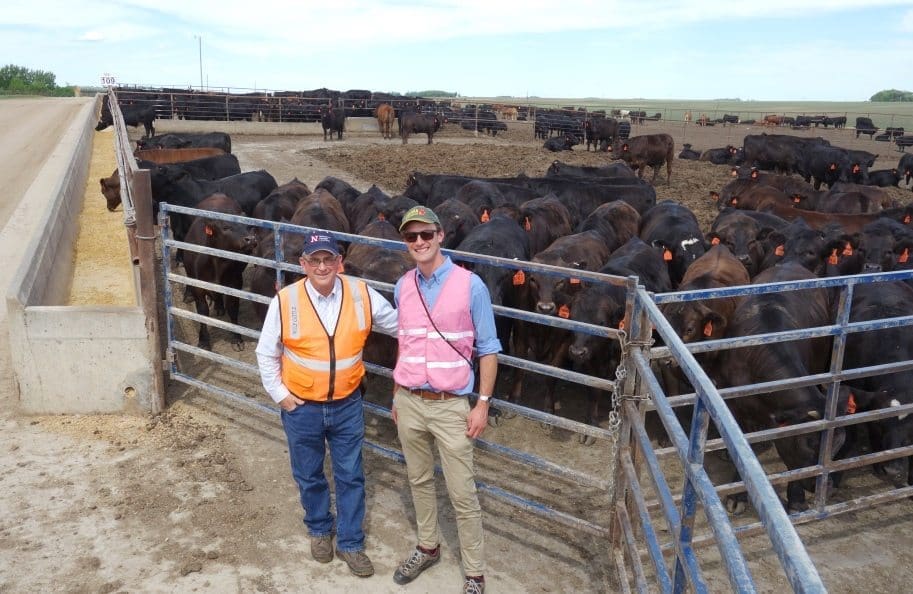AUSTRALIA should look at production models practised in New Zealand and Denmark to find ways to better utilise unwanted dairy bulls calves in beef production, a Nuffield scholar has suggested.
Better utilisation of dairy bull calves would not only respond to some consumers’ concerns about the treatment of dairy calves, but also potentially improve profitability for farmers, 2015 Nuffield Scholar Thomas Snare found.

Nuffield scholar Thomas Snare, right, with lotfeeder Jerry Wulf from Wulf Cattle, Minnesota with Jersey x Limousin feeder cattle.
Mr Snare has been researching the topic, looking at ways to market the already expanding dairy industry by rearing bull calves for beef consumption.
A dairy farmer near Boat Harbour in Tasmania, Mr Snare is also a farm manager at the Tasmanian Institute of Agriculture Dairy Research Facility run by the University of Tasmania.
He hopes the findings of his scholarship help to drive greater improvements on-farm, particularly in terms of utilising dairy bull calves, so as to ensure best practice and welfare standards across the industry.
And at a time when the beef sector is at 20 year lows in its beef herd cycle, an additional stream of slaughter stock for beef would be welcomed with open arms.
“Dairy bull calves are currently an underutilised co-product of dairy farming,” Mr Snare said.
“There is a real opportunity to value-add here in Australia, as seen in countries like the United Kingdom and the United States, where dairy origin beef makes up a significant proportion of total beef production.”
There were a number of factors that would drive greater success, including the need for farmers to produce quality bull calves and utilise beef genetics to increase carcase quality, he suggested.
Mr Snare’s Nuffield Scholarship was supported by Dairy Australia, and enabled him to visit and learn first-hand from industry leaders in New Zealand, Japan, Western and Northern Europe, and the US Mid-West.
He said the experience was unparalleled.
“It allowed me to look at the utilisation of dairy bred bull calves and the practicalities of rearing at large-scale, which is most successful when using a contracting rearing model,” Mr Snare said.
“It showed that there is a quality issue with the Jersey and Jersey cross bull calves currently produced in Australia, which in part can be corrected by better use of beef genetics, post artificial-insemination. It’s also important to know that the seasonal nature of dairy production in Australia means lower asset utilisation in comparison to year-round calving systems in other countries.”
“Working at all these elements – and keeping a closer eye on the beef market – so to look for opportunities to value add will be beneficial in producing more, with less.”
Thinking lean
A key aspect of his study program was completing a tour of Toyota in Japan to build a greater understanding of ‘lean management’, which is a system utilised by the manufacturing business worldwide to drive productivity improvements of up to 20-30 percent.
“You don’t often think of applying lean management in agriculture,” he said. “But there are some real productivity gains to be made, which at the same time address public concerns around the treatment of young dairy calves.
“Adding value to these animals, such as rearing and finishing at heavier weights, seems like a better solution and needs to continue to gain traction. Applying the principles of lean management will require 100 percent buy-in from management, basic theory education for the farm team and ongoing coaching from an external consultant.
From the implementation models he observed, the Danish and New Zealand approaches seemed most effective, providing basic training before working on gaining rapid improvements in the workplace.
Mr Snare said he was buoyed by the ongoing demand for Australian beef and the opportunity to capitalise upon this in the dairy industry, while contributing to animal welfare outcomes.
“Overall, the medium to long-term demand for Australian beef is positive,” he said.
“Processors will be prepared to come to the table for beef derived from dairy bulls, provided quality and volume can be guaranteed. And if we can achieve that, it will be positive for our animals, our industry and our businesses.”
Click the link below to view a short video presentation on Tom Snare’s findings.
Source: Nuffield
